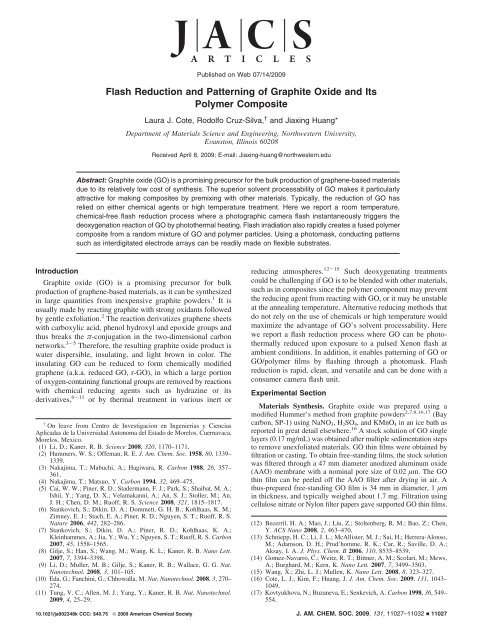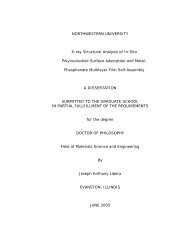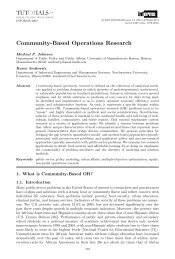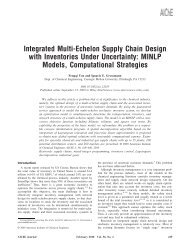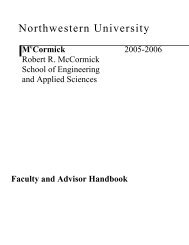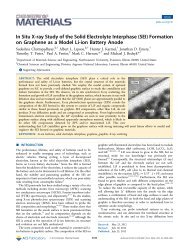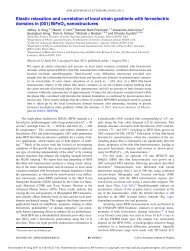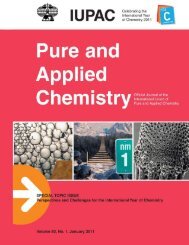Flash Reduction and Patterning of Graphite Oxide ... - Jiaxing Huang
Flash Reduction and Patterning of Graphite Oxide ... - Jiaxing Huang
Flash Reduction and Patterning of Graphite Oxide ... - Jiaxing Huang
You also want an ePaper? Increase the reach of your titles
YUMPU automatically turns print PDFs into web optimized ePapers that Google loves.
Published on Web 07/14/2009<br />
<strong>Flash</strong> <strong>Reduction</strong> <strong>and</strong> <strong>Patterning</strong> <strong>of</strong> <strong>Graphite</strong> <strong>Oxide</strong> <strong>and</strong> Its<br />
Polymer Composite<br />
Laura J. Cote, Rodolfo Cruz-Silva, † <strong>and</strong> <strong>Jiaxing</strong> <strong>Huang</strong>*<br />
Department <strong>of</strong> Materials Science <strong>and</strong> Engineering, Northwestern UniVersity,<br />
EVanston, Illinois 60208<br />
Received April 8, 2009; E-mail: <strong>Jiaxing</strong>-huang@northwestern.edu<br />
Abstract: <strong>Graphite</strong> oxide (GO) is a promising precursor for the bulk production <strong>of</strong> graphene-based materials<br />
due to its relatively low cost <strong>of</strong> synthesis. The superior solvent processability <strong>of</strong> GO makes it particularly<br />
attractive for making composites by premixing with other materials. Typically, the reduction <strong>of</strong> GO has<br />
relied on either chemical agents or high temperature treatment. Here we report a room temperature,<br />
chemical-free flash reduction process where a photographic camera flash instantaneously triggers the<br />
deoxygenation reaction <strong>of</strong> GO by photothermal heating. <strong>Flash</strong> irradiation also rapidly creates a fused polymer<br />
composite from a r<strong>and</strong>om mixture <strong>of</strong> GO <strong>and</strong> polymer particles. Using a photomask, conducting patterns<br />
such as interdigitated electrode arrays can be readily made on flexible substrates.<br />
Introduction<br />
<strong>Graphite</strong> oxide (GO) is a promising precursor for bulk<br />
production <strong>of</strong> graphene-based materials, as it can be synthesized<br />
in large quantities from inexpensive graphite powders. 1 It is<br />
usually made by reacting graphite with strong oxidants followed<br />
by gentle exfoliation. 2 The reaction derivatizes graphene sheets<br />
with carboxylic acid, phenol hydroxyl <strong>and</strong> epoxide groups <strong>and</strong><br />
thus breaks the π-conjugation in the two-dimensional carbon<br />
networks. 3-5 Therefore, the resulting graphite oxide product is<br />
water dispersible, insulating, <strong>and</strong> light brown in color. The<br />
insulating GO can be reduced to form chemically modified<br />
graphene (a.k.a. reduced GO, r-GO), in which a large portion<br />
<strong>of</strong> oxygen-containing functional groups are removed by reactions<br />
with chemical reducing agents such as hydrazine or its<br />
derivatives, 6-11 or by thermal treatment in various inert or<br />
† On leave from Centro de Investigacion en Ingenierias y Ciencias<br />
Aplicadas de la Universidad Autonoma del Estado de Morelos, Cuernavaca,<br />
Morelos, Mexico.<br />
(1) Li, D.; Kaner, R. B. Science 2008, 320, 1170–1171.<br />
(2) Hummers, W. S.; Offeman, R. E. J. Am. Chem. Soc. 1958, 80, 1339–<br />
1339.<br />
(3) Nakajima, T.; Mabuchi, A.; Hagiwara, R. Carbon 1988, 26, 357–<br />
361.<br />
(4) Nakajima, T.; Matsuo, Y. Carbon 1994, 32, 469–475.<br />
(5) Cai, W. W.; Piner, R. D.; Stadermann, F. J.; Park, S.; Shaibat, M. A.;<br />
Ishii, Y.; Yang, D. X.; Velamakanni, A.; An, S. J.; Stoller, M.; An,<br />
J. H.; Chen, D. M.; Ru<strong>of</strong>f, R. S. Science 2008, 321, 1815–1817.<br />
(6) Stankovich, S.; Dikin, D. A.; Dommett, G. H. B.; Kohlhaas, K. M.;<br />
Zimney, E. J.; Stach, E. A.; Piner, R. D.; Nguyen, S. T.; Ru<strong>of</strong>f, R. S.<br />
Nature 2006, 442, 282–286.<br />
(7) Stankovich, S.; Dikin, D. A.; Piner, R. D.; Kohlhaas, K. A.;<br />
Kleinhammes, A.; Jia, Y.; Wu, Y.; Nguyen, S. T.; Ru<strong>of</strong>f, R. S. Carbon<br />
2007, 45, 1558–1565.<br />
(8) Gilje, S.; Han, S.; Wang, M.; Wang, K. L.; Kaner, R. B. Nano Lett.<br />
2007, 7, 3394–3398.<br />
(9) Li, D.; Muller, M. B.; Gilje, S.; Kaner, R. B.; Wallace, G. G. Nat.<br />
Nanotechnol. 2008, 3, 101–105.<br />
(10) Eda, G.; Fanchini, G.; Chhowalla, M. Nat. Nanotechnol. 2008, 3, 270–<br />
274.<br />
(11) Tung, V. C.; Allen, M. J.; Yang, Y.; Kaner, R. B. Nat. Nanotechnol.<br />
2009, 4, 25–29.<br />
reducing atmospheres. 12-15 Such deoxygenating treatments<br />
could be challenging if GO is to be blended with other materials,<br />
such as in composites since the polymer component may prevent<br />
the reducing agent from reacting with GO, or it may be unstable<br />
at the annealing temperature. Alternative reducing methods that<br />
do not rely on the use <strong>of</strong> chemicals or high temperature would<br />
maximize the advantage <strong>of</strong> GO’s solvent processability. Here<br />
we report a flash reduction process where GO can be photothermally<br />
reduced upon exposure to a pulsed Xenon flash at<br />
ambient conditions. In addition, it enables patterning <strong>of</strong> GO or<br />
GO/polymer films by flashing through a photomask. <strong>Flash</strong><br />
reduction is rapid, clean, <strong>and</strong> versatile <strong>and</strong> can be done with a<br />
consumer camera flash unit.<br />
Experimental Section<br />
Materials Synthesis. <strong>Graphite</strong> oxide was prepared using a<br />
modified Hummer’s method from graphite powders 2,7,8,16,17 (Bay<br />
carbon, SP-1) using NaNO 3 ,H 2 SO 4 , <strong>and</strong> KMnO 4 in an ice bath as<br />
reported in great detail elsewhere. 16 A stock solution <strong>of</strong> GO single<br />
layers (0.17 mg/mL) was obtained after multiple sedimentation steps<br />
to remove unexfoliated materials. GO thin films were obtained by<br />
filtration or casting. To obtain free-st<strong>and</strong>ing films, the stock solution<br />
was filtered through a 47 mm diameter anodized aluminum oxide<br />
(AAO) membrane with a nominal pore size <strong>of</strong> 0.02 μm. The GO<br />
thin film can be peeled <strong>of</strong>f the AAO filter after drying in air. A<br />
thus-prepared free-st<strong>and</strong>ing GO film is 34 mm in diameter, 1 μm<br />
in thickness, <strong>and</strong> typically weighed about 1.7 mg. Filtration using<br />
cellulose nitrate or Nylon filter papers gave supported GO thin films.<br />
(12) Becerril, H. A.; Mao, J.; Liu, Z.; Stoltenberg, R. M.; Bao, Z.; Chen,<br />
Y. ACS Nano 2008, 2, 463–470.<br />
(13) Schniepp, H. C.; Li, J. L.; McAllister, M. J.; Sai, H.; Herrera-Alonso,<br />
M.; Adamson, D. H.; Prud’homme, R. K.; Car, R.; Saville, D. A.;<br />
Aksay, I. A. J. Phys. Chem. B 2006, 110, 8535–8539.<br />
(14) Gomez-Navarro, C.; Weitz, R. T.; Bittner, A. M.; Scolari, M.; Mews,<br />
A.; Burghard, M.; Kern, K. Nano Lett. 2007, 7, 3499–3503.<br />
(15) Wang, X.; Zhi, L. J.; Mullen, K. Nano Lett. 2008, 8, 323–327.<br />
(16) Cote, L. J.; Kim, F.; <strong>Huang</strong>, J. J. Am. Chem. Soc. 2009, 131, 1043–<br />
1049.<br />
(17) Kovtyukhova, N.; Buzaneva, E.; Senkevich, A. Carbon 1998, 36, 549–<br />
554.<br />
10.1021/ja902348k CCC: $40.75 © 2009 American Chemical Society J. AM. CHEM. SOC. 2009, 131, 11027–11032 9 11027
ARTICLES<br />
Polystyrene colloids with average diameters <strong>of</strong> 300 nm were<br />
synthesized by suspension polymerization according to a reported<br />
procedure. 18 A stock solution <strong>of</strong> about 1.4 wt % <strong>of</strong> polystyrene<br />
beads was obtained after purification. Since both GO colloids <strong>and</strong><br />
polystyrene colloids are processable in water, they can be mixed<br />
with any fraction to produce a blend with nearly arbitrary GO<br />
loading. GO/polystyrene composite films were prepared by filtering<br />
their mixed colloidal dispersion through Nylon (0.45 μm pore size)<br />
or AAO filters (0.2 μm nominal pore size) <strong>and</strong> dried at room<br />
temperature. Before flashing, the films were dried for another 10<br />
min in a 90 °C oven to remove residual water.<br />
<strong>Flash</strong> <strong>Reduction</strong> <strong>of</strong> GO. Most <strong>of</strong> the flash reduction experiments<br />
were carried out in air. Under N 2 atmosphere inside a glovebox, it<br />
was found that lower flash energy (indicated by the f/stops on the<br />
flash units) was needed to achieve reduction. This was attributed<br />
to more effective heating <strong>of</strong> GO because <strong>of</strong> reduced water content<br />
in GO. <strong>Flash</strong> reduction <strong>of</strong> free-st<strong>and</strong>ing GO films can be done with<br />
a single, close-up (
<strong>Flash</strong> <strong>Reduction</strong> <strong>and</strong> <strong>Patterning</strong> <strong>of</strong> <strong>Graphite</strong> <strong>Oxide</strong><br />
ARTICLES<br />
Figure 1. A graphite oxide (GO) paper (a) can be instantaneously reduced (b) upon exposure to a photographic camera flash. The grids in the background<br />
are1mm× 1 mm. The flash reduction <strong>of</strong> GO was evident by the dramatic changes in color (a, b), water contact angle (insets), (c) TGA, <strong>and</strong> (d) FTIR. In<br />
c, d, f, the blue lines correspond to GO <strong>and</strong> the red lines correspond to the flash reduced GO (r-GO). (e) Cross-sectional view <strong>of</strong> a GO paper showing large<br />
thickness expansion after flash reduction. Only the right half <strong>of</strong> the GO sample was flashed. The left part <strong>of</strong> the picture shows the cross-sectional view <strong>of</strong><br />
the light brown colored GO film. The thickness increased by almost 2 orders <strong>of</strong> magnitude, resulting in a very fluffy <strong>and</strong> potentially high surface area film.<br />
(f) The lack <strong>of</strong> a graphitic peak in the XRD pattern <strong>of</strong> the reduced material suggests disordered packing <strong>of</strong> the r-GO sheets, consistent with the large volume<br />
expansion observed in e.<br />
broad peak centered at 22.5° emerged, which is at a slightly<br />
lower angle than the peak for bulk graphite. The lack <strong>of</strong> a<br />
graphite peak suggests that the r-GO sheets stayed exfoliated<br />
<strong>and</strong> disorderly packed despite their strong π-π interaction. 23<br />
This is not surprising since flash irradiation causes microscopically<br />
explosive reduction <strong>of</strong> GO that occurs in situ in solid state.<br />
The density <strong>of</strong> flash-converted graphene films were calculated<br />
to be around 0.14 g/cm 3 , which is 6% <strong>of</strong> the value for bulk<br />
graphite. The conductivities <strong>of</strong> flash-reduced GO films were<br />
measured to be around 1000 S/m using their much exp<strong>and</strong>ed<br />
thicknesses in the calculation. Note that the conductivity <strong>of</strong><br />
reduced GO heavily depends on the processing history <strong>of</strong> the<br />
GO precursor, the reaction conditions, <strong>and</strong> densities <strong>of</strong> the final<br />
products. Although much higher values <strong>of</strong> conductivities have<br />
(22) Dikin, D. A.; Stankovich, S.; Zimney, E. J.; Piner, R. D.; Dommett,<br />
G. H. B.; Evmenenko, G.; Nguyen, S. T.; Ru<strong>of</strong>f, R. S. Nature 2007,<br />
448, 457–460.<br />
(23) Fujimoto, H. Carbon 2003, 41, 1585–1592.<br />
been reported for GO coatings <strong>of</strong> tens <strong>of</strong> nanometers in thickness<br />
annealed at high temperature (>500 °C), 12,15 for GO papers<br />
prepared under similar conditions, flash reduction produces<br />
products with comparable conductivities to those from chemical<br />
or thermal treatments. 7,9,13,14,24-26 The open structure <strong>of</strong> the<br />
flash-reduced GO thin films should make them useful for<br />
applications favoring high surface area. 25<br />
To underst<strong>and</strong> the photothermal heating mechanism, we<br />
investigated the photo energy input from the camera flash unit<br />
<strong>and</strong> the thermal energy needed for heating GO films to thermal<br />
reduction temperature (Figure 2). The photo energy emitted by<br />
the flash lamp used for Figure 1 <strong>and</strong> Video S1 was measured<br />
to be around 1 J/cm 2 at close distances (
ARTICLES<br />
Cote et al.<br />
Figure 2. Energy analysis on the flash reduction <strong>of</strong> graphite oxide. (a) The closeup <strong>of</strong> the DSC data (inset) shows the heating curve <strong>of</strong> GO up to 100 °C.<br />
The total energy input can be calculated from the area under the heating curve. It took about 377 J/g (i.e., 70 mJ/cm 2 ) <strong>of</strong> thermal energy to heat up the GO<br />
film from room temperature. (b) UV/vis spectrum <strong>of</strong> a 1 μm thick GO film. The average absorption over the visible range (400-800 nm) is 63%.<br />
Figure 3. Dry flash lithography <strong>of</strong> GO. Left: A shadow mask defining an<br />
exposed area with “N” shape was taped onto a GO film supported by filter<br />
paper. Center: The black, N-shaped, r-GO pattern obtained after flash. Right:<br />
The exposed area was ablated by higher power flashes, leaving an etched<br />
“N” pattern on the film.<br />
typical optical absorption <strong>of</strong> a 1 μm thick GO film is about<br />
63% in the visible range, the total absorbed energy is about<br />
630 mJ/cm 2 . Using differential scanning calorimetry (DSC), the<br />
total thermal energy required to heat a 1 μm thick GO to 100<br />
°C is calculated to be about 70 mJ/cm 2 . Note that this value<br />
already includes the extra energy needed to heat <strong>and</strong> evaporate<br />
the 15% water in the GO film. Therefore, a single camera flash<br />
at this distance can provide 9 times the thermal energy needed<br />
for heating GO over 100 °C, which should be more than enough<br />
to induce deoxygenating reactions. This suggests that flash<br />
irradiation could lead to a much higher degree <strong>of</strong> reduction <strong>of</strong><br />
GO if the photothermal conversion <strong>and</strong> heat absorption by GO<br />
are optimized. It was also found that much lower energy flashes<br />
(
<strong>Flash</strong> <strong>Reduction</strong> <strong>and</strong> <strong>Patterning</strong> <strong>of</strong> <strong>Graphite</strong> <strong>Oxide</strong><br />
ARTICLES<br />
Figure 5. Scalable production <strong>of</strong> functional r-GO based devices on flexible substrates by flash patterning. (a) Arrays <strong>of</strong> r-GO/polystyrene interdigitated<br />
electrodes (IDE) were fabricated on a 1.5 in. diameter GO/polystyrene thin film deposited on a Nylon filter paper. The inset shows the close up view <strong>of</strong> one<br />
set <strong>of</strong> such IDE. The contact pads are 5 mm × 5 mm. The electrode fingers are 100 μm wide. As a pro<strong>of</strong> <strong>of</strong> concept, the graphene IDEs were used to<br />
construct ammonia sensors with polyaniline as the selective layer. The response from such a metal-free, flexible sensor device on exposure to 100 ppm <strong>of</strong><br />
ammonia vapor is shown in b.<br />
well processable in water <strong>and</strong> alcohols because <strong>of</strong> the strong<br />
electrostatic repulsion between the single layers. 8,16 But r-GO<br />
tends to agglomerate in solution because <strong>of</strong> π-π stacking,<br />
greatly limiting the concentration <strong>of</strong> single layer solutions. For<br />
making an r-GO/polymer composite, it would be ideal to make<br />
a GO/polymer blend first to take full advantage <strong>of</strong> the excellent<br />
processability <strong>of</strong> GO. r-GO/polymer composites with near<br />
arbitrary loading levels can be rapidly fabricated by flash<br />
reduction from a blend <strong>of</strong> GO <strong>and</strong> polymer particles. An<br />
additional advantage is that the excess heat generated can be<br />
utilized to induce welding between the polymer <strong>and</strong> the r-GO<br />
sheets. A pro<strong>of</strong>-<strong>of</strong>-concept experiment was shown in Figure 4<br />
where GO is flash-reduced <strong>and</strong> welded with polystyrene beads.<br />
First, GO single layers <strong>and</strong> polystyrene colloids were mixed in<br />
water with a predetermined fraction. Then films <strong>of</strong> a GO/<br />
polystyrene mixture were made by filtration. Such thin “filter<br />
cakes”, if detached from the filter paper, were brittle <strong>and</strong> cracked<br />
easily upon manipulation as shown in the low magnification<br />
SEM image (Figure 4a <strong>and</strong> 4b, inset). The SEM image also<br />
revealed a r<strong>and</strong>om blend <strong>of</strong> polystyrene beads with GO (Figure<br />
4a). After flash irradiation, GO was reduced <strong>and</strong> the polystyrene<br />
particles <strong>and</strong> GO were fused together, leading to a continuous,<br />
conducting film (Figure 4b <strong>and</strong> inset). The deformation <strong>of</strong><br />
polymer colloids can be clearly observed in the TEM images,<br />
where the polymer particles were deliberately s<strong>and</strong>wiched<br />
between two GO thin films using layer by layer deposition<br />
(Figure 4c). The spreading <strong>of</strong> molten polystyrene on the r-GO<br />
sheets was evident after flashing (Figure 4d). The thickness <strong>of</strong><br />
each GO film is estimated to be no more than 35 nm based on<br />
the widths <strong>of</strong> the folds. <strong>Flash</strong> irradiation on these thin films<br />
was able to generate sufficient heat to s<strong>of</strong>ten the polystyrene<br />
beads. Without GO, flash irradiation had little effect on the<br />
colloids (see Supporting Information, Figure S2) since polystyrene<br />
is transparent in the visible range. In the GO/polystyrene<br />
films, the polymer particles can act as a heat sink to drain away<br />
the excess heat to avoid overexposure during patterning. This<br />
helps to improve the resolution <strong>of</strong> the patterns <strong>and</strong> the integrity<br />
<strong>of</strong> the reduced domains.<br />
Because many properties <strong>of</strong> GO are altered after reduction<br />
such as color, electrical conductivity, thermal stability, surface<br />
energy, wettability <strong>and</strong> chemical reactivity, flash reduction, <strong>and</strong><br />
patterning <strong>of</strong> GO is especially promising for fabricating<br />
functional surfaces <strong>and</strong> devices. For example, Figure 5a shows<br />
arrays <strong>of</strong> interdigitated r-GO/polystyrene electrodes fabricated<br />
on a flexible, 1.5 in. Nylon “wafer” upon flashing through a<br />
mask printed on a sheet <strong>of</strong> overhead transparency. A GO/<br />
polystyrene blend was used as the precursor to improve the<br />
resolution <strong>and</strong> mechanical durability <strong>of</strong> the patterned films. The<br />
exposed areas became conducting with the sheet resistance<br />
decreased significantly from 2 × 10 8 Ω/ to 9.5 kΩ/square. The<br />
flashed areas also became more hydrophobic. Such electrodes<br />
were used to construct chemical vapor sensors by depositing<br />
some conducting polymer polyaniline nan<strong>of</strong>ibers. When exposed<br />
to 100 ppm NH 3 vapor, such all-organic, flexible sensors showed<br />
comparable sensitivity (Figure 5b) <strong>and</strong> time response (see<br />
Supporting Information, Figure S3) to those made with conventional<br />
metal electrodes <strong>and</strong> hard substrates. 27 The wettability<br />
contrast between the electrode fingers <strong>and</strong> the blank areas may<br />
be further utilized to fabricate micr<strong>of</strong>luidic or electrowetting<br />
devices.<br />
Advancement in the processing technique can usually bring<br />
breakthroughs <strong>and</strong> discoveries in the materials as seen in the<br />
development <strong>of</strong> carbon nanotubes 28-30 <strong>and</strong> conducting polymers.<br />
31 Some inspiring results have been reported on flash<br />
treatment <strong>of</strong> nanomaterials such as single-walled carbon nanotubes,<br />
Si nanowires, <strong>and</strong> conducting polymer nan<strong>of</strong>ibers. 32-34<br />
However, in all these cases it caused the degradation <strong>of</strong> electrical<br />
conductivity. <strong>Flash</strong> irradiation <strong>of</strong> GO makes an insulating<br />
material conducting, enhancing its electrical conductivity by<br />
many orders <strong>of</strong> magnitude. Therefore, it could lead to many<br />
more useful applications. Compared to chemical <strong>and</strong> high<br />
temperature thermal treatments, flash reduction is rapid, chemical-free,<br />
<strong>and</strong> energy efficient. It could be an enabling technique<br />
that holds great promise for patterning GO films in device <strong>and</strong><br />
composite applications.<br />
Acknowledgment. We thank the National Science Foundation<br />
(SGER CMMI-0853573) for supporting this work. L.J.C. gratefully<br />
(27) <strong>Huang</strong>, J. X.; Virji, S.; Weiller, B. H.; Kaner, R. B. J. Am. Chem.<br />
Soc. 2003, 125, 314–315.<br />
(28) Banerjee, S.; Hemraj-Benny, T.; Wong, S. S. AdV. Mater. 2005, 17,<br />
17–29.<br />
(29) Liu, J.; Fan, S. S.; Dai, H. J. MRS Bull. 2004, 29, 244–250.<br />
(30) Sun, Y. P.; Fu, K. F.; Lin, Y.; <strong>Huang</strong>, W. J. Acc. Chem. Res. 2002,<br />
35, 1096–1104.<br />
(31) Skotheim, T. A.; Reynolds, J. R. H<strong>and</strong>book <strong>of</strong> conducting polymers,<br />
3rd ed.; CRC: London, 2007.<br />
(32) Ajayan, P. M.; Terrones, M.; de la Guardia, A.; Huc, V.; Grobert, N.;<br />
Wei, B. Q.; Lezec, H.; Ramanath, G.; Ebbesen, T. W. Science 2002,<br />
296, 705–705.<br />
(33) Wang, N.; Yao, B. D.; Chan, Y. F.; Zhang, X. Y. Nano Lett. 2003, 3,<br />
475–477.<br />
(34) <strong>Huang</strong>, J. X.; Kaner, R. B. Nat. Mater. 2004, 3, 783–786.<br />
J. AM. CHEM. SOC. 9 VOL. 131, NO. 31, 2009 11031
ARTICLES<br />
acknowledges the National Science Foundation for a graduate<br />
research fellowship. R.C.-S. gratefully acknowledges the Universidad<br />
Autonoma del Estado de Morelos for a postdoctoral fellowship<br />
to partially support his visit at Northwestern University. We thank<br />
J. Kellar for assistance in XPS measurement, K.N. Sohn <strong>and</strong> Q.<br />
Zhang for help with XRD, F. Kim for help with TEM, Pr<strong>of</strong>. K. R.<br />
Shull for use <strong>of</strong> his drop shape analyzer, <strong>and</strong> Pr<strong>of</strong>. S. T. Nguyen<br />
for discussion. We thank the NUANCE Center for use <strong>of</strong> their<br />
microscopy <strong>and</strong> surface analysis facilities. This work made use <strong>of</strong><br />
shared polymer characterization facilities supported by the NSF<br />
MRSEC program (DMR-0520513) at the Materials Research Center<br />
<strong>of</strong> Northwestern University.<br />
Supporting Information Available: Video <strong>of</strong> flash reduction<br />
process; TEM images <strong>of</strong> GO/PS <strong>and</strong> PS before <strong>and</strong> after flash;<br />
more data on ammonia sensing using polyaniline nan<strong>of</strong>ibers<br />
deposited on GO/PS electrodes. This material is available free<br />
<strong>of</strong> charge via the Internet at http://pubs.acs.org.<br />
JA902348K<br />
Cote et al.<br />
11032 J. AM. CHEM. SOC. 9 VOL. 131, NO. 31, 2009
Supporting Information<br />
<strong>Flash</strong> <strong>Reduction</strong> <strong>and</strong> <strong>Patterning</strong> <strong>of</strong> <strong>Graphite</strong> <strong>Oxide</strong> <strong>and</strong><br />
Its Polymer Composite<br />
Laura J. Cote, Rodolfo Cruz-Silva <strong>and</strong> <strong>Jiaxing</strong> <strong>Huang</strong>*<br />
Department <strong>of</strong> Materials Science <strong>and</strong> Engineering, Northwestern University<br />
Evanston, IL 60208 USA<br />
* Email: <strong>Jiaxing</strong>-huang@northwestern.edu<br />
Video S1. Snapshots from Video S1 showing a typical flash reduction experiment.<br />
S1
Figure S2. TEM images (a: before; b: after) <strong>of</strong> a s<strong>and</strong>wiched GO/polystyrene/GO structure clearly<br />
showing the s<strong>of</strong>tening <strong>of</strong> the polymer colloids after flash. The presence <strong>of</strong> GO sheets can be identified<br />
by the wrinkles. Without GO, the polystyrene beads (c: before; d: after) did not appear to be affected by<br />
the same flash exposure since polystyrene is transparent in the visible range, <strong>and</strong> therefore does not have<br />
a strong photothermal effect.<br />
S2
Figure S3. (a) Response <strong>of</strong> a polyaniline nan<strong>of</strong>iber sensor deposited on flash patterned r-<br />
GO/polystyrene interdigitated electrodes upon exposure to 100 ppm ammonia. (b) is a close up view <strong>of</strong><br />
the onset <strong>of</strong> the first cycle, showing the time response. These results are similar to those obtained with<br />
conventional metal electrodes on hard substrates 1 .<br />
SI References<br />
1. <strong>Huang</strong>, J.X., Virji, S., Weiller, B.H. & Kaner, R.B. J. Am. Chem. Soc. 125, 314-315 (2003).<br />
S3


